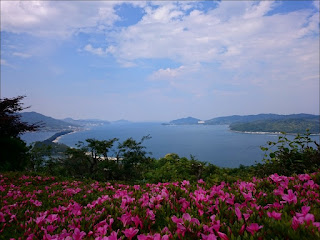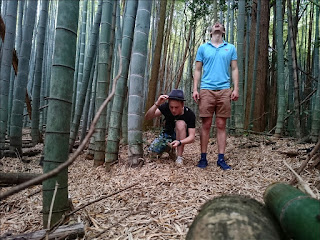Not that we had much of a choice, as there actually isn't much else to do there.
Situated on the northern coast of the Chuugoku region, Tottori prefecture is the least populous prefecture of Japan. This makes itself apparent in its capital, Tottori city. Juxtaposed to Tokyo, the buildings are low, old, rusty and many of them seem to be in a state of disuse and decay.
At day there are hardly any people to be seen on the streets and the main venue in the evening appears to be a Starbucks, from where I'm writing this post.
 |
| Tottori at dusk |
The biggest tourist attractions in Tottori are the sand dunes, located on the town's north-eastern shore, and a sand museum which lies adjacent to them.
That's where we went on the first day of our stay to take a beginner's course in paragliding.
After a rather awkward and somewhat clumsy reception of our instructors we packed our gear and headed out to the sand dunes. We did feel a little hesitant after the ambiguous, patchy and bewildering briefing of the instructors, uttered in an improvised Jenglisch. Being the men we are however, we didn't let that unsettle us too much and by using our colourful imagination we filled the gaps, added the essential details and took off.
And what an exciting and exhilarating experience it was! Indeed, the flights usually didn't last for more than half a minute, but they were surely long enough to give me a nice kick of adrenaline and make me crave for more...
I filmed one of Alessio's take-offs and all of my flights on the GoPro camera Alan had lent me (thanks Alan!) but I don't think I'll be able to upload the videos to the blog, as the file sizes are too large and we have no means of compressing them. Sorry guys :-(.
 |
| this was the approximate location for take-off |
Afterwards we went to the sand museum where a Germany-themed exhibition was being held.
The sculptures were awe-inspiring and the amount of detail simply amazing.
Convince yourself and take a look at the pictures! Can you guess what the different sculptures depict?
- Louis
As mentioned beforehand, we discussed on outdoor activities in Tottori. So we decided to go kayaking on our second day in Tottori. Immediately after arriving at the meeting point for the kayaking, we were welcomed by our guide Takaharu, who would accompany us on our little adventure. We very pleasently surprised and delighted by our guide's English skill. He spoke a very good English with almost no accent, which is very uncommon for Japanese people, especially in rural areas (remember our guides for the paragliding). After a short introduction we headed to the port, where we put out to see. After having gotten out of the port the beautiful and pristine nature welcomed us. We steered or kayak through caves and around peculiarly shaped rock formations. We indulged ourselves in the calm and relaxing atmosphere created by the sea and our surroundings. We both relished the kayaking a lot and would recommend it to anyone who is planning to visit Tottori.
Our thanks goes to our guide Takaharu for taking the following pictures.
Our thanks goes to our guide Takaharu for taking the following pictures.
We decided to have dinner at a close seafood restaurant, which according to our kayaking guide, should have been the best seafood restaurant in the area. Unfortunately we didn't get the chance to find out for ourselves, as the restaurant was already fully reserved when we arrived at 17:00. We spent the evening at Starbucks (again), since it seems to be the only place in all Tottori, where there are actually people. Now we are heading to Matsue, where we will spend the next two nights, posts about Matsue will follow.
- Alessio
- Alessio

















































